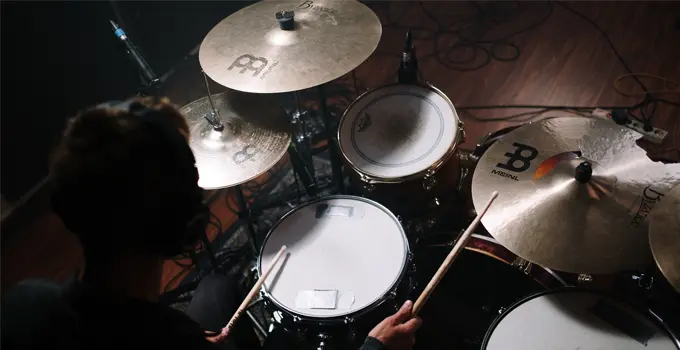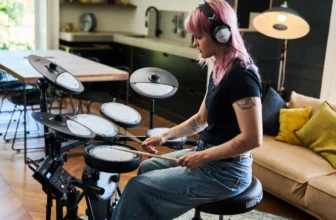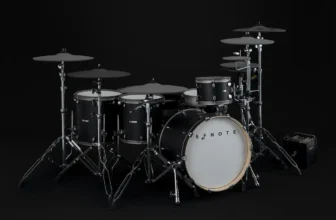

Whether you’ve stepped behind a drumkit or watched a drummer pummel a kit onstage from the safety of the audience, you know it takes work. From rock to R&B to pop, you can find drummers swinging their arms, tapping their feet, and moving their bodies to create the sounds of modern drumming.
For all drummers, we’re reminded of the physical demands of our instrument as our hands and thumbs cramp up before a big fill, or worse yet, when our ankle and calve muscles stiffen and burn as we head into the final minute of “Immigrant Song.”
For those of us who perform live, it’s palpable when you walk off stage sweaty and depleted with rustled hair while the guitarist and singer greet their legions of screaming fans with only a single bead of sweat invading their brow.
Numerous drumming legends can also attest to the physical demands: Neil Peart of Rush claimed he unintentionally lost 10 pounds in the three-and-a-half weeks of rehearsals leading up to Rush’s 2012 tour, and Tommy Lee of Mötley Crüe once clocked in 13.1 miles during a live performance using a pedometer attached to his right foot.
Our eyes and bodies can tell us one story, but science has now confirmed drumming can be a calorie-burning form of exercise. Still, how many calories are we actually laying upon the altar of drumming to fuel our playing?
The Science of Drumming and Calorie Burn
The science behind the number of calories burned while drumming can vary based on several factors: your body weight, the intensity of your playing, and the duration of your session.
If you’re playing the drums at a moderate intensity for an hour, such as a jazz gig, you can expect to burn between 300 to 500 calories. More intense drumming sessions can burn close to 600 calories, the caloric equivalent of a 30-minute run or jumping rope for an hour. Drummer Lab, which follows Nadia Azar’s kinesiology research on some of the world’s best drummers, has found multiple pro-level rock drummers burning well over 1,000 calories in a single high-pressure rock performance under hot stage lights.
The reason why drumming burns so many calories per minute is that drumming is a full-body workout. While a casual observer may assume it is relegated to the work of the hands, wrists, and feet, drumming engages multiple muscle groups in the arms, legs, back, and core while encompassing elements of aerobic, anaerobic, and strength training.
The recruitment of these muscle groups and the heightened demand for oxygen in the body leads to increased energy usage (caloric burn). The more intensely and frequently these muscles are used while playing, the higher the burn likely to occur.
In 2008, The Clem Burke Drumming Project was founded by drummer Clem Burke of Blondie, Professor Steve Draper (Hartpury University, UK), and Professor Marcus Smith (University of Chichester, UK) to take a deep dive into the science that connects fitness and drumming.
From 1997 to 2007, Smith and his team ran tests on Burke, measuring his heart rate, oxygen uptake, and the levels of lactic acid in his blood while performing on tour. As a result, Burke’s heart rate averaged 145 beats per minute on stage, with peaks of 190 beats per minute throughout the performance. The study also worked with drummers from Bloc Party and Primal Scream, who burned nearly 600 calories an hour in concert.
They found in this study that drumming can bring your heart rate, which for most people typically rests at 75 beats per minute, to nearly 200 beats per minute at varying intensity intervals.
In addition, breathing frequency can also increase from 15 to 50 breaths per minute, which increases blood flow and regulates blood pressure. These intensified breathing patterns and heart rates cause drumming to crossover into cardiovascular exercise, which burns more calories.
The critical thing to remember with alternative fitness activities like drumming is that your body has no idea what is causing an increased demand for caloric energy; it just knows the need is there. This rule is why your muscles don’t grow any differently whether you lift a 30-pound water jug or a 30-pound weight at the gym. The stresses and demands on your body are the same.

Movement Patterns
When you break down the action of drumming into movement patterns, the fact that calories are burned at a higher rate becomes even less surprising. Every big drum stroke, cymbal crash, or boom on the toms mimics the same movement patterns of a tricep extension, deltoid eccentric raise, lat pulldown, and hammer curl.
Vigorous fills around the kit resemble battle ropes—an exercise Travis Barker has used to prepare for tours—and hi-hat and bass drum pedal work resembles calf or ankle raises.
The grip strength required to hold and control your sticks while playing, especially in heavier music, and the lateral core movements needed to move around the kit also mimic that of calisthenics. Your torso must also absorb the constant shock of your arms repeatedly hitting the drums and cymbals, especially at higher intensities.
For live performers, the not-so-simple act of having to move your gear from one location to another adds an entirely new element of fitness. Hauling a hardware case or drums to and from a vehicle or up a dreaded flight of stairs can resemble a deadlift, farmers carry, or bicep curl, and carrying your backpack cymbal bag is no different from a weighted ruck.
The legitimacy of drumming as a calorie-burning activity has spawned drumming-specific fitness classes (Cardio drumming) such as Drums Alive® and Pound, which combine traditional aerobic movements with participants pounding large exercise balls with drumsticks.
Beyond the physical realm, the mental strain of synchronizing your body and using different levels of limb independence, dexterity, and intensity throughout a drum performance also leads to calories burned. Like chess players who can burn 6,000 calories in a competition, the mental aspects of drumming, especially in a performance environment, lead to an increased demand for energy from the brain.
Player Specific
That said, just because you are drumming doesn’t necessarily mean you’re burning through calories. For example, while the BBC reported in 2008 that playing the drums for a rock band requires the stamina of a Premier League footballer, these tests were performed on rock drummers under the pressure of live performances and beneath hot stage lights.
Mechanical efficiency, technique, and the body’s ability to adapt to unfamiliar movements will also affect your ability to burn calories behind the kit. The concept of “plateauing,” or becoming conditioned to perform at a certain intensity, occurs because the body has become more effective and efficient in dealing with the stressors of a particular activity.
This term is often used in exercise science to describe athletes who stop seeing strength increases after 4-6 months of continuous training. The same can happen with drumming: the number of calories burned during a session will decrease as the session becomes less strenuous due to physical adaptations.
Along with plateauing, a player’s technique can negatively affect caloric expenditure. The more comfortable you become with a certain intensity, the less exhausting it will be.
Further, the more your technique improves, the fewer calories you’ll burn executing the same parts. Similar patterns are found across exercise movements, where more experienced and technical players can move faster and for more extended periods than novice ones.
But before you start setting fire to your copies of Stick Control in the name of caloric expenditure, remember that just because you’re a skilled player doesn’t mean you can’t achieve the same caloric output a newbie would have. It just means you need to challenge yourself more to do so.
The Big Picture
No matter how you approach it, drumming will always, first and foremost, be a form of creative expression. Whether using your sticks on a modern drumkit or your hands on traditional drums, drumming is a great way to channel your energy creatively.
The cherry on top is that it can also be a great way to burn calories. When performed regularly, it can help you enhance your overall physical conditioning and strength and improve your endurance and cardiovascular health.
A healthy relationship with your drums is a healthy lifestyle supported by good mental health, physical health, a solid diet, and other factors. Knowing how many calories you can burn while drumming will help you plan a healthy and active lifestyle and inform a healthy diet.
Remember, though, the number of calories burned while drumming is player-specific and will vary based on body weight, intensity, experience, technique, and the duration and context of your playing.
You must continually challenge your body and mind to get results. So the more you practice, the more calories you can burn. It’s one more reason to love our instrument.




